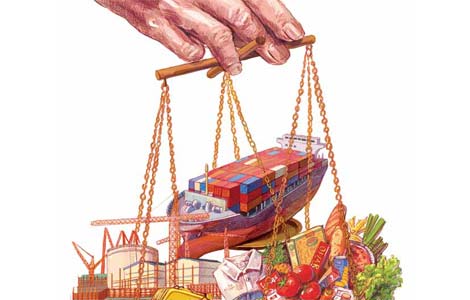Financial reform cannot wait
Updated: 2013-06-24 07:15
By Murtaza Syed (China Daily)
|
|||||||||||
China's financial system is changing fast. Non-bank activities - including those dealing in wealth management products, trust loans and corporate bonds - have mushroomed since the global crisis. In many ways, this is a welcome diversification. However, disorderly growth of the non-bank sector could pose a threat of financial instability and erosion of macroeconomic control in the coming years.
To forestall this risk, China needs to reform its financial system. Without such reform, it will also be difficult to sustain rapid economic growth and rebalance the economy toward consumption. So as China's new leaders embark upon a new era of much-needed reforms, transforming the financial system is appropriately a key item on the agenda.
China's financial sector is flush with liquidity, both because of the high level of savings held domestically by China's capital account restrictions, and large inflows associated with the country's balance of payments surpluses and intervention in the management of the exchange rate. To prevent this liquidity from fueling dangerous lending booms, the People's Bank of China mainly uses direct tools like quantitative limits on bank credit and increases in bank reserve requirements.
In contrast, interest rate hikes are used more sparingly as they conflict with other goals - both loan and deposit rates are kept low to provide cheap credit to certain enterprises, protect bank margins and subsidize the sterilization of foreign exchange intervention.
So why should we worry about the status quo? We should be concerned primarily because quantitative controls on credit are creating enormous incentives for banks to find other ways to lend, including off-balance sheet and through informal means, which is risky and could begin to compromise macroeconomic control over time. Moreover, China's financial system perpetuates its unbalanced growth model by under-pricing capital and depressing interest rates, which suppresses household income and consumption while subsidizing corporate sector investment and savings.
So the rationale for financial reform in China is powerful. However, international experience cautions that many countries that have tried to liberalize their financial sector have lost control over monetary aggregates and that reform must be appropriately sequenced to avoid risks. What might such a road map look like for China?
First, relative prices - including the exchange rate - could be determined more by the market so as to stem the continuous inflow of liquidity. At the same time, the stock of excess liquidity would need to be absorbed by issuing central bank bills and moving to a point where interest rates clear the credit market, not quantity controls. This would facilitate a shift away from quantitative limits on credit toward the use of conventional monetary tools. Significantly, it will also help the central bank to run a more active, independent and counter-cyclical monetary policy.
Second, implicit public guarantees of financial institutions need to be explicitly withdrawn at an early stage. Such blanket backing should be replaced with deposit insurance. It could be complemented by continuously reforming and commercializing the State-owned banks. Ensuring that banks face hard budget constraints is an important prerequisite for a more commercially oriented banking system that adequately prices risk and efficiently allocates credit. This would also help prevent banks from taking undue risks as interest rates are liberalized, restrictions on bank activities eased and new markets opened.
Nevertheless, some financial institutions may need to be wound down as the process unfolds and must be allowed to exit in an orderly way by improving the resolution framework. In all of the above, transparency will be paramount, with the objective being to create a predictable and rules-based system that allows proper pricing of risks and handling of shocks.
Third, a key lesson from the global crisis is that as the financial system is liberalized, regulation and supervision must be continuously upgraded to monitor and identify macrofinancial vulnerabilities. Within this, it will be important to ensure that investors fully bear the losses on assets backing non-deposit instruments in order to promote risk-awareness and counter the perception that investments are implicitly guaranteed.
Fourth, interest rates should be liberalized, beginning in the near-term by increasing the upward flexibility of deposit rates. This will help reduce regulatory arbitrage that currently favors wealth management products over bank deposits. Full liberalization of deposit and lending rates could be completed over time based on prevailing conditions.
Fully liberalizing interest rates too early in the process - particularly before a more nimble monetary policy and better regulation and supervision are in place - would risk "over-competition" by banks that erodes margins or precipitates a dangerous lending spree. Liberalization should lead to higher interest rates, in large part to reflect the true risk premium, which to date has been implicitly subsidized by the government.
Fifth, capital markets need to be further developed to help improve the pricing and allocation of capital, while also providing households and investors with a broader range of potential saving instruments. It would call for further efforts to encourage the development of mutual funds, corporate bonds, equities, annuities and insurance, as well as building a stronger institutional investor base. However, financial market development should be coordinated and not advanced too far ahead of banking reform, lest deposits start to flow out of banks in a disruptive manner.
And finally, as a more robust system of monetary control, market-determined interest rates, a strong prudential regulatory system and a more flexible exchange rate are put in place, China will be well-positioned to gradually free up controls on capital flows. Such steps also will permit China to internationalize the renminbi at an appropriate pace, thus making its currency more freely usable for international trade and finance.
Fittingly, many of the above reforms figure prominently in the 12th Five Year-Plan (2011-15) as well as the new leadership's announcements of policy priorities. Surely, important progress has been made along this path in recent years, including through greater flexibility on both deposit and lending rates, macroprudential measures to contain risks in the non-bank sector, and the steps taken to gradually open up the capital account. Looking ahead, China needs to accelerate the pace of these changes.
Done right, financial liberalization would be the next big wave of reform that China needs. It could be as significant as the State-owned enterprise reform of the 1990s. Through financial liberalization, China would be able to make enormous gains in productivity and lay the foundation for continued strong growth in coming decades.
The author is the IMF's deputy resident representative in China.
(China Daily 06/24/2013 page9)
Today's Top News
US 'stole' China's statistics
Mountaineers killed in Pakistan
Foreign firms eye new 'opening-up'
Suspect in shooting spree detained
Stock market to lift ban on shares worth $5b
Central bank reiterates prudent monetary policy
Profiting out of Africa comes with risks
Project halted due to bird nests
Hot Topics
Lunar probe , China growth forecasts, Emission rules get tougher, China seen through 'colored lens', International board,
Editor's Picks

|

|

|

|

|

|





